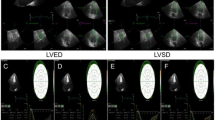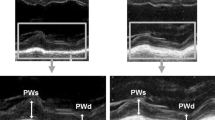Abstract
Longitudinal deformation has been shown to deteriorate with progressive aortic stenosis as well as ischemic heart disease. Despite that both conditions share risk factors and are often coexisting, studies have not assessed the influence on longitudinal deformation for both conditions simultaneously. Thus the purpose of this study was to evaluate the association between subclinical ischemic heart disease and global and regional longitudinal strain in asymptomatic patients with significant aortic stenosis. Prevalent patients with a diagnosis of aortic stenosis at six hospitals in the Greater Copenhagen area were screened for inclusion. A total of 104 asymptomatic patients with moderate-severe aortic stenosis (aortic valve area ≤1.5 cm2) fulfilled study criteria and underwent advanced echocardiographic analysis and coronary angiography by multi-detector computed tomography. Angiography revealed coronary stenosis >50 % in 31 % (n = 32). All regional longitudinal strain measures (apical, mid and basal longitudinal strain) were significant predictors of significant coronary stenosis (>70 % stenosis), but only apical and mid longitudinal strain were significant predictors in multivariable analyses independent of aortic valve area, stroke volume index, pro-BNP, valvulo-arterial impedance, body mass index and heart rate. In linear regression models with both aortic valve area and significant coronary stenosis, apical (p < 0.001) and mid (p < 0.01) longitudinal strain were associated to significant coronary stenosis but not aortic valve area. Conversely, basal longitudinal strain was significantly associated to aortic valve area (p = 0.001), but not to significant coronary stenosis. Subclinical coronary artery disease is frequent in moderate and severe aortic stenosis, and should be suspected when regional longitudinal dysfunction is predominant in the apical and mid ventricular segments.



Similar content being viewed by others
Abbreviations
- MDCT:
-
Multi detector computed tomography
- GLS:
-
Global longitudinal strain
- ALS:
-
Apical longitudinal strain
- MLS:
-
Mid longitudinal strain
- BLS:
-
Basal longitudinal strain
- CV:
-
Coefficient of variation
References
Stewart BF, Siscovick D, Lind BK et al (1997) clinical factors associated with calcific aortic valve disease. J Am Coll Cardiol 29:630–634
Morrison GW, Thomas RD, Grimmer SF, Silverton PN, Smith DR (1980) Incidence of coronary artery disease in patients with valvular heart disease. Br Heart J 44:630–637
Ramsdale DR, Bennett DH, Bray CL, Ward C, Beton DC, Faragher EB (1984) Angina, coronary risk factors and coronary artery disease in patients with valvular disease. A prospective study. Eur Heart J 5:716–726
Bourantas CV, Zhang Y-J, Garg S, et al (2014) Prognostic implications of coronary calcification in patients with obstructive coronary artery disease treated by percutaneous coronary intervention: a patient-level pooled analysis of 7 contemporary stent trials. Heart heartjnl–2013–305180
Hou Z, Lu B, Gao Y et al (2012) Prognostic value of coronary CT angiography and calcium score for major adverse cardiac events in outpatients. JACC Cardiovasc Imaging 5:990–999
Arad Y, Spadaro LA, Goodman K, Newstein D, Guerci AD (2000) Prediction of coronary events with electron beam computed tomography. J Am Coll Cardiol 36:1253–1260
Biering-Sorensen T, Hoffmann S, Mogelvang R et al (2014) Myocardial strain analysis by 2-dimensional speckle tracking echocardiography improves diagnostics of coronary artery stenosis in stable angina pectoris. Circ Cardiovasc Imaging 7:58–65
Choi J-O, Cho SW, Song YB et al (2009) Longitudinal 2D strain at rest predicts the presence of left main and three vessel coronary artery disease in patients without regional wall motion abnormality. Eur J Echocardiogr 10:695–701
Attias D, Macron L, Dreyfus J et al (2013) Relationship between longitudinal strain and symptomatic status in aortic stenosis. J Am Soc Echocardiogr 26:868–874
Ng ACT, Delgado V, Bertini M et al (2011) Alterations in multidirectional myocardial functions in patients with aortic stenosis and preserved ejection fraction: a two-dimensional speckle tracking analysis. Eur Heart J 32:1542–1550
Larsen LH, Kofoed KF, Carstensen HG et al (2014) Aortic valve area assessed with 320-detector computed tomography: comparison with transthoracic echocardiography. Int J Cardiovasc Imaging 30:165–173
Lang RM, Bierig M, Devereux RB et al (2006) Recommendations for chamber quantification. Eur J Echocardiogr 7:79–108
Baumgartner H, Hung J, Bermejo J et al (2009) Echocardiographic assessment of valve stenosis: EAE/ASE recommendations for clinical practice. J Am Soc Echocardiogr 22:1–23
Raff GL, Abidov A, Achenbach S et al (2009) SCCT guidelines for the interpretation and reporting of coronary computed tomographic angiography. J Cardiovasc Comput Tomogr 3:122–136
Austen WG, Edwards JE, Frye RL, et al (1975) A reporting system on patients evaluated for coronary artery disease. Report of the ad hoc committee for grading of coronary artery disease, council on cardiovascular surgery. American Heart Association. Circulation 51:5–40
Go AS, Mozaffarian D, Roger VL, et al (2013) Heart disease and stroke statistics—2013 update. A report from the American Heart Association. Circulation 127:e6–e245
Gaziano TA, Bitton A, Anand S, Abrahams-Gessel S, Murphy A (2010) Growing epidemic of coronary heart disease in low- and middle-income countries. Curr Probl Cardiol 35:72–115
Greenbaum RA, Ho SY, Gibson DG, Becker AE, Anderson RH (1981) Left ventricular fibre architecture in man. Br Heart J 45:248–263
Reimer KA, Lowe JE, Rasmussen MM, Jennings RB (1977) The wavefront phenomenon of ischemic cell death. 1. Myocardial infarct size vs duration of coronary occlusion in dogs. Circulation 56:786–794
Dunn RB, Griggs DM (1975) Transmural gradients in ventricular tissue metabolites produced by stopping coronary blood flow in the dog. Circ Res 37:438–445
Algranati D, Kassab GS, Lanir Y (2011) Why is the subendocardium more vulnerable to ischemia? A new paradigm. AJP Heart Circ Physiol 300:H1090–H1100
Dellsperger KC, Marcus ML (1988) The effects of pressure-induced cardiac hypertrophy on the functional capacity of the coronary circulation. Am J Hypertens 1:200–207
Mahmod M, Francis JM, Pal N et al (2014) Myocardial perfusion and oxygenation are impaired during stress in severe aortic stenosis and correlate with impaired energetics and subclinical left ventricular dysfunction. J Cardiovasc Magn Reson 16:29
Hoffmann S, Mogelvang R, Sogaard P et al (2011) Tissue Doppler echocardiography reveals impaired cardiac function in patients with reversible ischaemia. Eur J Echocardiogr 12:628–634
Bruch C, Stypmann J, Grude M, Gradaus R, Breithardt G, Wichter T (2004) Tissue Doppler imaging in patients with moderate to severe aortic valve stenosis: clinical usefulness and diagnostic accuracy. Am Heart J 148:696–702
MacGregor DC, Covell JW, Mahler F, Dilley RB, Ross J Jr (1974) Relations between afterload, stroke volume, and descending limb of Starling’s curve. Am J Physiol 227:884–890
Ersbøll M, Valeur N, Mogensen UM et al (2012) Relationship between left ventricular longitudinal deformation and clinical heart failure during admission for acute myocardial infarction: a two-dimensional speckle-tracking study. J Am Soc Echocardiogr 25:1280–1289
Gjesdal O, Helle-Valle T, Hopp E et al (2008) Noninvasive separation of large, medium, and small myocardial infarcts in survivors of reperfused ST-elevation myocardial infarction a comprehensive tissue doppler and speckle-tracking echocardiography study. Circ Cardiovasc Imaging 1:189–196
Morris DA, Otani K, Bekfani T et al (2014) Multidirectional global left ventricular systolic function in normal subjects and patients with hypertension: multicenter evaluation. J Am Soc Echocardiogr 27:493–500
Lafitte S, Perlant M, Reant P et al (2009) Impact of impaired myocardial deformations on exercise tolerance and prognosis in patients with asymptomatic aortic stenosis. Eur J Echocardiogr 10:414–419
Baltabaeva A, Marciniak M, Bijnens B et al (2008) Regional left ventricular deformation and geometry analysis provides insights in myocardial remodelling in mild to moderate hypertension. Eur J Echocardiogr 9:501–508
Richand V, Lafitte S, Reant P et al (2007) An ultrasound speckle tracking (two-dimensional strain) analysis of myocardial deformation in professional soccer players compared with healthy subjects and hypertrophic cardiomyopathy. Am J Cardiol 100:128–132
Serri K, Reant P, Lafitte M et al (2006) Global and regional myocardial function quantification by two-dimensional strain: application in hypertrophic cardiomyopathy. J Am Coll Cardiol 47:1175–1181
Phelan D, Collier P, Thavendiranathan P et al (2012) Relative apical sparing of longitudinal strain using two-dimensional speckle-tracking echocardiography is both sensitive and specific for the diagnosis of cardiac amyloidosis. Heart 98:1442–1448
Heng MK, Janz RF, Jobin J (1985) Estimation of regional stress in the left ventricular septum and free wall: an echocardiographic study suggesting a mechanism for asymmetric septal hypertrophy. Am Heart J 110:84–90
Basford JR (2002) The law of laplace and its relevance to contemporary medicine and rehabilitation. Arch Phys Med Rehabil 83:1165–1170
Weidemann F, Herrmann S, Störk S et al (2009) Impact of myocardial fibrosis in patients with symptomatic severe aortic stenosis. Circulation 120:577–584
Chow BW, Freeman MR, Bowen JM et al (2011) Ontario multidetector computed tomographic coronary angiography study: field evaluation of diagnostic accuracy. Arch Intern Med 171:1021–1029
Larsen LH, Kofoed KF, Dalsgaard M et al (2013) Assessment of coronary artery disease using coronary computed tomography angiography in patients with aortic valve stenosis referred for surgical aortic valve replacement. Int J Cardiol 168:126–131
Utsunomiya H, Yamamoto H, Kitagawa T et al (2013) Incremental prognostic value of cardiac computed tomography angiography in asymptomatic aortic stenosis: significance of aortic valve calcium score. Int J Cardiol 168:5205–5211
Herzog BA, Wyss CA, Husmann L et al (2009) First head-to-head comparison of effective radiation dose from low-dose 64-slice CT with prospective ECG-triggering versus invasive coronary angiography. Heart 95:1656–1661
Acknowledgments
Alfred Helsted & Eli Moellers foundation, Th. Maigaards Lily Benthine Lunds Foundation, Jens Anker Andersen Foundation and Raimond & Dagmar Ringgaard-Bohns Foundation. The sponsors had no role in the study design, data collection, data analysis, data interpretation, or writing of the manuscript.
Conflict of interest
Dr. Kofoed has received lecture fees from Toshiba Medical Systems.
Author information
Authors and Affiliations
Corresponding author
Rights and permissions
About this article
Cite this article
Carstensen, H.G., Larsen, L.H., Hassager, C. et al. Association of ischemic heart disease to global and regional longitudinal strain in asymptomatic aortic stenosis. Int J Cardiovasc Imaging 31, 485–495 (2015). https://doi.org/10.1007/s10554-014-0572-z
Received:
Accepted:
Published:
Issue Date:
DOI: https://doi.org/10.1007/s10554-014-0572-z




